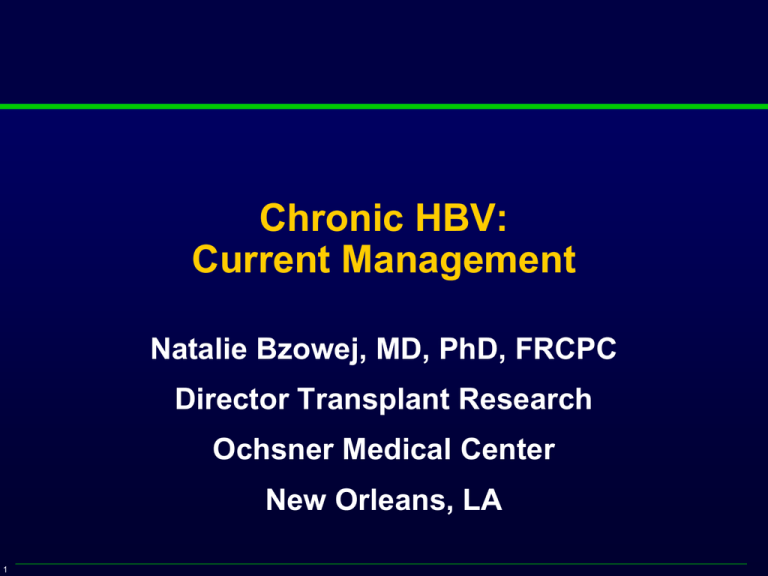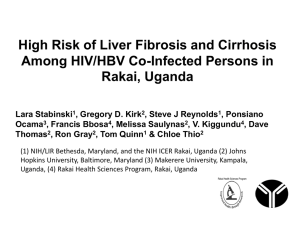
Chronic HBV:
Current Management
Natalie Bzowej, MD, PhD, FRCPC
Director Transplant Research
Ochsner Medical Center
New Orleans, LA
1
Chronic HBV: Current Management
Agenda
● Screening Guidelines
● Prevalence (global and in the US)
● Phases of Hepatitis B
● Natural History
● Overview of Treatment
2
Case 1
30 year-old white male in for routine check up
Patient reports no problems with health
No significant personal or family history
Wife was recently found to be HBsAg+
•O/E
•No stigmata of CLD
•Exam normal
•Would you screen the patient for hepatitis B?
3
Case 2
47-year-old woman born in the US comes in
for a routine physical
PMHx and Family Hx unremarkable
Social hx - parents immigrated from Korea
Would you screen this patient for hepatitis B?
4
Case 3
22-year-old Chinese woman born in China
comes in for physical
c/o fatigue and nausea
PMHx and Family Hx unremarkable
Social Hx: immigrated at the age of 2
Would you screen this patient for hepatitis B?
5
Candidates for Screening for HBV
Weinbaum CM, et al. MMWR Recomm Rep. 2008;57(RR-8):1-20.
● Household and sexual contacts of HBsAg-positive persons
● US born children of immigrants from high-risk areas
● Persons born in high endemic areas (>2% prevalence)
● Persons who have ever injected drugs
● Persons with multiple sexual partners, or history of STDs
● Men who have sex with men
● Inmates of correctional facilities
● Individuals infected with HIV or HCV
● Patients undergoing dialysis
● All pregnant women
● Individuals with chronically elevated ALT/AST
6
Prevalence of HBV:
Global Estimates
HBsAg Prevalence
High (>8%)
Intermediate (2%-7%)
Low (<2%)
Weinbaum CM, et al. MMWR Recomm Rep. 2008;57(RR-8):1-20.
7
HBV Infection in the United States
● Revised HBV prevalence in the United States taking
into account recent estimates of foreign-born persons
- 847,145 to 2,243,757 persons with chronic HBV
- Average chronic HBV prevalence rate among
foreign-born persons living in the United States is
2.0% to 5.4%
Kowdley KV, et al. Hepatology. 2012;56:422-433.
8
Estimated HBV Prevalence
Among Foreign-Born Americans (2009)
Chronic HBV Prevalence (%)
Foreign-Born Americans:
13.6% of General Population
11.8%
7.9%
3.7%
2.3%
1.3%
2.2%
1.6%
0.3%
All Foreign
Born
(n=41,329,349)
Asia
(n=10,970,572)
Central
America
Caribbean
(n=3,588,352)
(n=16,068,537)
Kowdley KV, et al. Hepatology. 2012;56:422-433.
9
South
America
(n=2,856,583)
Africa
Europe
(n=1,669,101)
(n=5,113,072)
North
America
(n=888,318)
Upper Limit of Normal ALT Levels
● Updated upper limits
-
Males: 30 U/L (-25% from prior ULN)
Females: 19 U/L (-37% from prior ULN)
● Based on retrospective cohort study
-
6835 first time blood donors 1995-1999
• Anti-HCV negative and no contraindication to donation
● ALT activity independently related to
-
BMI
Abnormal lipid or carbohydrate metabolism
Keeffe EB, et al. Clin Gastroenterol Hepatol. 2008;6:1315-1341.
Prati D, et al. Ann Intern Med. 2002;137:1-9.
10
CASE 1: 30 yr old male
Labs
•HBsAg+, HBeAg+, Anti-HBe–, Anti-HBc (IgM)–
•HBV DNA: 1,263,500 IU/mL, ALT: 128 U/L
In what phase is this patient?
Is this patient a candidate for treatment?
If treatment is indicated, what treatment would
you choose?
What clinical and laboratory markers will you
assess to determine effectiveness and duration?
11
CASE 2 (47 yr old Asian female)
Labs
•HBsAg+, HBeAg-, Anti-Hbe+
•HBV DNA: 1,300 IU/mL, ALT: 17 U/L
In what phase is this patient?
Is this patient a candidate for treatment?
12
CASE 3 (22 yr old Asian female)
Labs
•HBsAg+, HBeAg+, Anti-Hbe•HBV DNA: 33,000,000 IU/mL, ALT: 12 U/L
In what phase is this patient?
Is this patient a candidate for treatment?
13
4 Phases of Chronic HBV Infection
1. Immune tolerance phase
- HBeAg positive; high HBV DNA (105-10 copies/mL); normal ALT
2. HBeAg-positive chronic hepatitis (immune clearance)
- High HBV DNA (105-10 copies/mL); high or fluctuating ALT; active
inflammation on liver biopsy
3. Inactive HBsAg carrier (low or non-replication)
- HBeAg negative; low HBV DNA (<104 copies/mL); normal ALT
- HBsAg may become undetectable
4. HBeAg-negative chronic hepatitis (precore/bcp mutant)
- Intermediate to high HBV DNA (104-8 copies/mL); high or fluctuating
ALT; active inflammation on liver biopsy
Pungpapong S, et al. Mayo Clin Proc. 2007;82:967-975.
14
CASE 1: 30 yr old male
Labs
•HBsAg+, HBeAg+, Anti-HBe–, Anti-HBc (IgM)–
•HBV DNA: 1,263,500 IU/mL, ALT: 128 U/L
In what phase is this patient?
HBeAg-positive chronic hepatitis
(immune clearance)
15
CASE 2 (47 yr old Asian female)
Labs
•HBsAg+, HBeAg-, Anti-Hbe+
•HBV DNA: 1,300 IU/mL, ALT: 17 U/L
In what phase is this patient?
Inactive HBsAg carrier (low or no replication)
16
CASE 3 (22 yr old Asian female)
Labs
•HBsAg+, HBeAg+, Anti-Hbe•HBV DNA: 33,000,000 IU/mL, ALT: 12 U/L
In what phase is this patient?
Immune tolerance phase
17
Chronic HBV Infection:
Disease Progression
Disease Progression Occurs in 15% to 40% With Chronic HBV Infection
Liver Cancer
(HCC)
5%-10%
10%-15%
in 5 years
Chronic HBV
Infection
30%
Acute
Flare
Cirrhosis
Liver
Transplantation*
23% in
5 years
Liver Failure
*Chronic HBV infection is the 6th leading cause for liver transplantation the United States.
Fattovich G, et al. Gastroenterology. 2004;127:S35-S50.
Seef LB, et al. Hepatology. 2001;33:455-463.
Torresi J, et al. Gastroenterology. 2000;118:S83-S103.
Fattovich G, et al. Hepatology. 1995;21:77-82.
18
Death
Chronic HBV: Goals of Therapy
● Control disease (not cure) by limiting viral replication
-
Sustained suppression of HBV replication
Prevent cirrhosis, hepatic failure, and HCC
● Markers of treatment response
- Decreased serum HBV DNA to low/undetectable levels
• Improved liver histology
• Decreased or normalized serum ALT
● Endpoints of treatment
• HBeAg loss or seroconversion (in HBeAg+ patients)
• HBsAg loss or seroconversion
Lok AS, et al. Hepatology. 2009;50:661-662. Available at: http://www.aasld.org.
Keeffe EB, et al. Clin Gastroenterol Hepatol. 2008;6:1315-1341.
19
NIH Guidelines:
Candidates for HBV Therapy
● HBV therapy indicated
- Acute liver failure
- Cirrhosis and clinical complications
- Cirrhosis or advanced fibrosis and HBV DNA in serum
- Receiving cancer chemotherapy or
immunosuppressive therapy
● HBV therapy may be indicated
- Chronic HBV (HBeAg positive or negative) without
advanced fibrosis or cirrhosis
Sorrell MF, et al. Ann Intern Med. 2009;150:104-110.
20
NIH Guidelines: Immediate HBV
Therapy Is Not Routinely Indicated
● Immune-tolerant phase
-
HBeAg positive, high HBV DNA levels, normal ALT or
little activity on liver biopsy
● Inactive carrier phase
-
HBsAg positive, low or undetectable HBV DNA levels,
persistently normal ALT
● Latent HBV infection
- Detectable HBV DNA levels without HBsAg
Sorrell MF, et al. Ann Intern Med. 2009;150:104-110.
21
Approved Treatments for HBV
Generic Name
Manufacturer
Year Approved for HBV
Schering Corporation
1991
Lamivudine
GlaxoSmithKline
1998
Adefovir dipivoxil
Gilead Sciences
2002
Entecavir
Bristol-Myers Squibb
2005
Peginterferon alfa-2a
Hoffmann La-Roche
2005
Idenix
2006
Gilead Sciences
2008
Interferon alfa-2b
Telbivudine
Tenofovir DF
22
Candidates for HBV Treatment
HBV DNA
threshold (IU/L)
HBeAg positive
HBeAg negative
ALT:
Normal range
When to treat:
key factors
Biopsy
APASL
(2008)
EASL
(2009)
Keeffe et al
(2008)
AASLD
(2009)
20,000
2000
2000
2000
20,000
2000
20,000
2000-20,000
-
-
Use revised,
lower range
Use revised,
lower range
(M: 30 U/L; F: 19 U/L)
(M: 30 U/L; F: 19 U/L)
HBV DNA
and ALT
HBV DNA
and ALT
HBV DNA
and ALT
HBV DNA
and ALT
Consider in
certain groups
Consider in
certain groups
Consider in
certain groups
Consider in
certain groups
Lok AS, et al. Hepatology. 2009;50:661-662. Available at: http://www.aasld.org/Pages/Default.aspx.
Keeffe EB, et al. Clin Gastroenterol Hepatol. 2008;6:1315-1341.
EASL. J Hepatol. 2009:50:227-242.
Liaw Y-F, et al. Hepatol Int. 2008;2:263-283.
23
AASLD Guidelines:
HBeAg-Positive Patients (non-cirrhotic)
HBV DNA
(IU/mL)
ALT
(x ULN)
Management
Recommendation
>20,000
<2
Observe
Consider biopsy in persons >40 years of age, ALT
persistently high normal, or with family history of
hepatocellular carcinoma
Consider treatment if biopsy shows moderate or
severe inflammation or significant fibrosis
>2
Observe for 3 to 6 months and treat if no
spontaneous HBeAg loss
Immediate treatment if icteric or clinical decompensation
Consider liver biopsy prior to treatment if compensated
Lamivudine and telbivudine not preferred due to
high rate of resistance
IU/mL to copies/mL conversion:
Versant HBV DNA 3.0 (bDNA): 1 IU/mL=5.2 copies/mL.
Cobas Amplicor HBV monitor: 1 IU/mL=5.6 copies/mL.
Cobas TaqMan 48 HBV: 1 IU/mL=5.8 copies/mL.
Preferred
Drugs
Case 1: ALT (128),
HBV DNA (1,263,500 IU/mL)
Lok AS, et al. Hepatology. 2009;50:661-662. Available at: http://www.aasld.org.
24
Tenofovir DF
Entecavir
Peginterferon
AASLD Guidelines:
HBeAg-Negative Patients (non-cirrhotic)
HBV DNA
ALT
(IU/mL)
(x ULN)
Management
Recommendation
>20,000
>2
Treat
Lamivudine and telbivudine not preferred
due to high rate of resistance
2000 to
20,000
1-2
Consider biopsy
Treat if biopsy shows moderate/severe
necroinflammation or significant fibrosis
<2000
<1
Observe
Treat if HBV DNA or ALT becomes higher
IU/mL to copies/mL conversion:
Versant HBV DNA 3.0 (bDNA): 1 IU/mL=5.2 copies/mL.
Cobas Amplicor HBV monitor: 1 IU/mL=5.6 copies/mL.
Cobas TaqMan 48 HBV: 1 IU/mL=5.8 copies/mL.
Preferred
Drugs
Tenofovir DF
Entecavir
Peginterferon
Case 2:
HBV DNA: 1,300 IU/mL, ALT: 17 U/L
Lok AS, et al. Hepatology. 2009;50:661-662. Available at: http://www.aasld.org.
25
AASLD Guidelines: HBeAg-Positive
or Negative Patients With Cirrhosis
HBV DNA
(IU/mL)
Detectable
ALT
(x ULN)
Management
Recommendation
Cirrhosis Compensated
Treat if HBV DNA >2000 IU/mL
Consider treatment if HBV
DNA is <2000 IU/mL and
ALT is elevated
Decompensated
Refer for transplantation
Undetectable
Preferred
Drugs
Tenofovir DF
Entecavir
Lamivudine (or telbivudine)
+ adefovir, tenofovir DF or
entecavir
Cirrhosis Compensated
Observe
Decompensated
Refer for transplantation
IU/mL to copies/mL conversion:
Versant HBV DNA 3.0 (bDNA): 1 IU/mL=5.2 copies/mL.
Cobas Amplicor HBV monitor: 1 IU/mL=5.6 copies/mL.
Cobas TaqMan 48 HBV: 1 IU/mL=5.8 copies/mL.
Lok AS, et al. Hepatology. 2009;50:661-662. Available at: http://www.aasld.org.
26
Duration of HBV Treatment
● HBeAg-positive
-
An additional 12 months after HBeAg seroconversion to
reduce relapse rate (non-cirrhotics)
● HBeAg-negative
-
Relapse common after cessation of therapy
Long-term treatment currently recommended
● Cirrhosis
- Long-term therapy required or until HBsAg loss
- Combination therapy may be considered
Keeffe EB, et al. Clin Gastroenterol Hepatol. 2008;6:1315-1341.
27
Case 1
30 year-old male, eAg+, high ALT, high HBV DNA
liver biopsy: stage 2 fibrosis
genotype A
Treated with pegasys x 48 weeks
finite treatement duration
Check ALT, HBV DNA at 1, 3, 6 and 12 months
Virus negative at 24, 48 and 72 weeks
eAg- loss, eAb + at 2 years
sAg loss at 5 years
28
HBV Genotyping and Response to Therapy
● At least 8 genotypes have been
identified
-
Type A: North America, northern
Europe, India, and Africa
-
Types B and C: Asia
Type G: United States and Europe
Type H: Central America and
California
● HBeAg-negative precore mutant
seen more frequently in genotypes
B, C, and D
100
HBeAg Seroconversion (%)
● Prevalence varies by geographic
region
Peginterferon alfa 2a
80
60
52%
40
30%
22%
20
0
A
B
C
D
(n=23)
(n=76)
(n=162)
(n=9)
Lok AS, et al. Hepatology. 2009;50:661-662. Available at: http://www.aasld.org.
Keeffe EB, et al. Clin Gastroenterol Hepatol. 2008;6:1315-1341.
Lau GK, et al. N Engl J Med. 2005;352:2682-2695.
29
31%
Case 1 (Alternate Scenario)
30 year-old male, eAg+, high ALT, high HBV DNA
liver biopsy: stage 2 fibrosis
Treated with tenofovir or entecavir
Check ALT, HBV DNA at 1, 3, 6 and 12 months
Monitor creatinine periodically
Virus becomes negative at 24 wks
HBeAg-, HBeAb+ at 4 yrs (treat for one more year)
6 mos off treatment HBV DNA 1500 IU/mL, ALT 33
HBeAg remains negative, HBeAb positive
Monitor HBV DNA q 3mos x 1 yr, then q 6 mos
Treat only if rising DNA and ALT
30
Cumulative Incidence of
Drug Resistance During HBV Therapy
HBV Treatment-Naïve Patients
(baseline wild-type virus)
100
Patients (%)
80
HBeAg status
Positive
Negative
Mixture of both
73%
60
40
29%
25%
20%
20
11%
0
1.2%
Lamivudine
5 Years
Adefovir
5 Years
Entecavir
6 Years
0%
0%
Tenofovir DF
4 Years
Lok AS, et al. Hepatology. 2009;50:661-662. Available at: http://www.aasld.org.
31
Telbivudine
2 Years
Summary
● Chronic HBV infection is a common problem that leads
to morbidity and mortality
● Understand the prevalence of your patient population
● A wide range of treatment options exist
● Treatment should be initiated and tailored to the
individual based on
- HBV DNA levels
- Elevated ALT or abnormal liver biopsy
- HBeAg status
- HBV genotype
● Tenofovir DF, entecavir, and peginterferon are preferred
first-line agents
32
A 25-year-old Asian female who is HBsAg (+) and HBeAg
(+) with serum HBV DNA of >170, 000, 000 int. unit/mL
has a serum ALT of 17 int. unit/L. Initial
evaluation of this patient with chronic hepatitis B should
not include:
A. History and physical
examination
B. Laboratory tests to assess liver
25%
disease - complete blood
counts with platelets, hepatic
panel, and prothrombin time
C. Tests to rule out viral
coinfections - anti-HCV, antiHIV
D. Liver biopsy to grade and stage
liver disease
A.
33
10
25%
25%
B.
C.
25%
D.
A patient with HBV and decompensated cirrhosis
can be treated with all of the following agents
except:
A.
B.
C.
D.
a) tenofovir
b) lamivudine
c) interferon
d) entecavir
25%
A.
34
25%
25%
B.
C.
25%
D.
10
Groups at high risk who should be
screened for HBV include:
A. ) Household and sexual
contacts of HBsAg-positive
20%
persons
B. b) Persons needing
immunosuppressive
therapy
C. c) Men who have sex with
men
D. d) Patients undergoing
renal dialysis
E. e) a, b, c and d
A.
35
10
20%
20%
B.
C.
20%
D.
20%
E.









